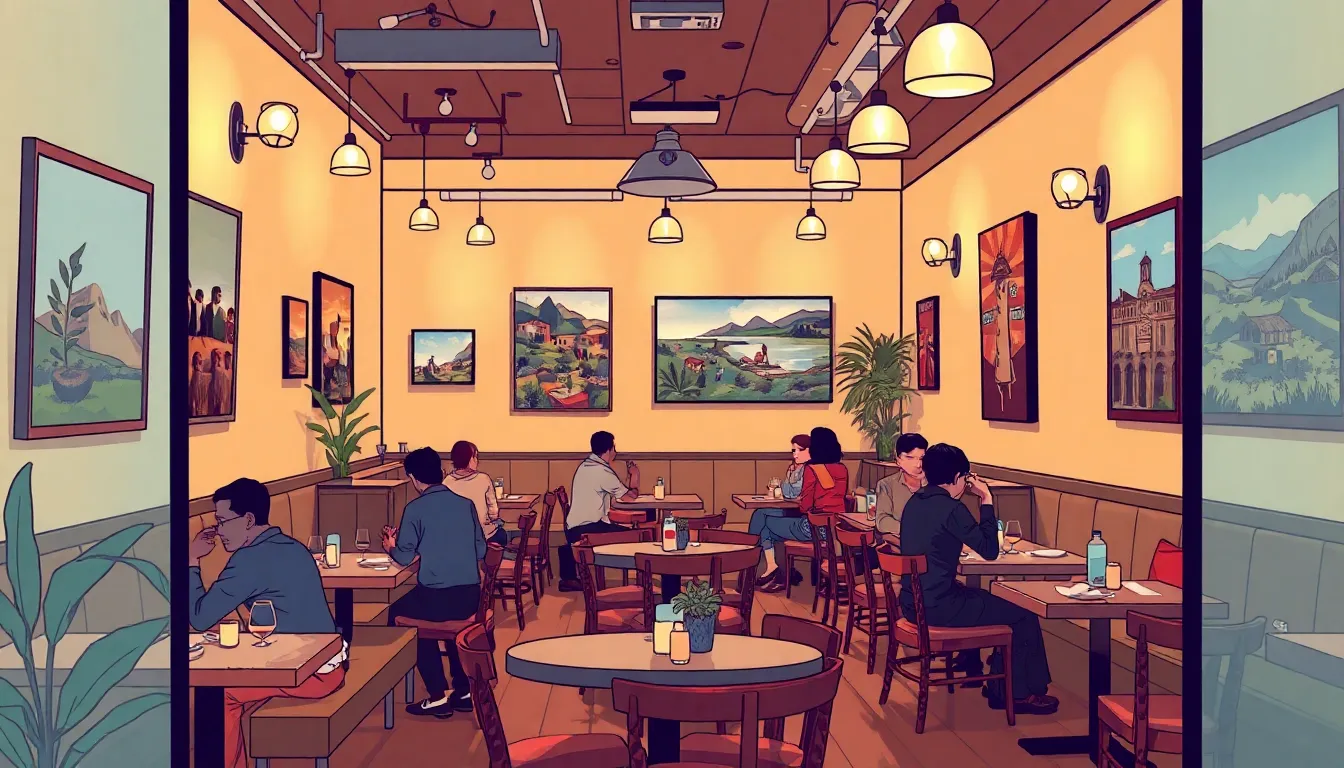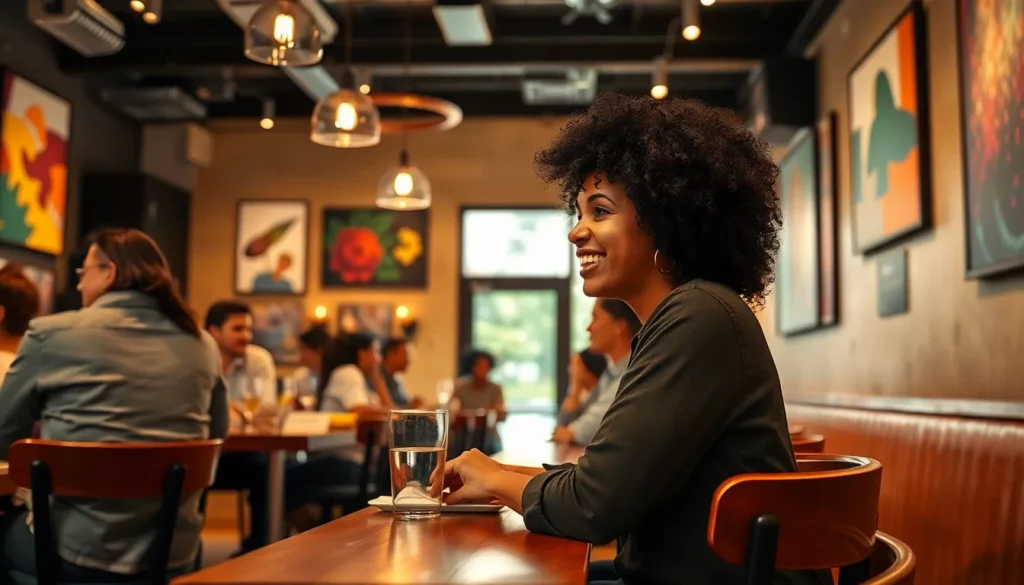In the bustling world of dining, the atmosphere can be just as important as the menu. Restaurant design concepts are the secret sauce that transforms a simple meal into an unforgettable experience. From cozy nooks that invite intimate conversations to vibrant spaces that spark joy, the right design can make patrons feel right at home—or like they’ve stepped into a culinary wonderland.
Table of Contents
ToggleOverview of Restaurant Design Concepts
Restaurant design encompasses various elements that contribute to a memorable dining experience. Color schemes influence mood and evoke emotions. Warm tones often create a cozy vibe, while bright shades can energize a space.
Layout plays a crucial role in functionality and flow. Well-planned seating arrangements ensure comfort and facilitate movement for both guests and staff. A balanced mix of table sizes caters to different group dynamics, encouraging both intimate dining and larger gatherings.
Lighting design adds depth to the overall ambiance. Dimmers and varied light sources foster versatility, allowing the atmosphere to shift from casual to formal as the day progresses. Unique fixtures, such as chandeliers or pendant lights, serve as focal points while enhancing the décor.
Furniture selection impacts both aesthetics and comfort. Designers prioritize ergonomics, ensuring that chairs and tables complement the restaurant’s vision while keeping patrons comfortable. Eye-catching furniture pieces can create a signature look that sets the establishment apart.
Acoustic considerations cannot be overlooked. Sound-absorbing materials help maintain a pleasant noise level, promoting conversation without overwhelming guests. Background music also enhances the dining experience, with curated playlists adding to the overall atmosphere.
Incorporating local art or thematic decorations personalizes the space. Art installations or murals reflect the restaurant’s identity and connect patrons to the locale. Seasonal design updates keep the environment fresh, encouraging repeat visits.
Sustainability practices also shape modern restaurant design. Eco-friendly materials and energy-efficient appliances appeal to environmentally conscious diners. Implementing green practices demonstrates a commitment to social responsibility while attracting a loyal customer base.
Understanding these concepts helps restaurateurs create compelling environments. Each design choice directly influences how patrons perceive their dining experience.
Importance of Restaurant Design

Restaurant design plays a crucial role in shaping the overall dining experience. An inviting atmosphere can transform meals into memorable occasions, affecting patrons’ moods and willingness to return.
Enhancing Customer Experience
Comfortable seating arrangements foster relaxation and engagement. Pleasant color schemes create a welcoming vibe that encourages customers to linger. Functional layouts facilitate efficient service, while thoughtful lighting enhances the ambiance. Acoustic solutions minimize disruptive noise, allowing for conversation without strain. Incorporating artwork that reflects local culture adds an element of authenticity. Each design element contributes to a holistic experience that keeps diners returning for more.
Impact on Branding
Restaurant design serves as a visual representation of a brand’s identity. Unique design elements distinguish a restaurant from competitors, making it memorable. Consistent themes and styles reinforce brand messaging, creating a strong connection with patrons. Effective use of logos and colors can evoke specific emotions and expectations about the dining experience. Engaging decor helps tell a brand story that resonates with customers. Ultimately, a well-conceived design establishes brand loyalty through a cohesive and appealing environment.
Key Elements of Restaurant Design
Understanding key elements of restaurant design enhances the overall dining experience. Important aspects like layout, color, and lighting play vital roles in creating inviting atmospheres.
Layout and Space Planning
Effective layout and space planning ensure smooth operations. Efficient traffic patterns facilitate movement between dining areas, kitchens, and restrooms. Consideration of table arrangements promotes conversation while maximizing seating capacity. Open spaces create a sense of community, while intimate nooks offer privacy. Additionally, appropriate placement of service stations reduces staff workload, enhancing customer service.
Color and Lighting Schemes
Color and lighting schemes significantly influence mood. Warm colors, such as reds and oranges, stimulate appetite, whereas cooler tones promote relaxation. Matching lighting levels with design elements enhances ambiance and guides attention to focal points. Soft, ambient lights create coziness, while brighter options support lively environments. Choosing fixtures and colors that align with brand identity strengthens recognition and enhances customer expectations.
Popular Restaurant Design Styles
Various restaurant design styles appeal to diverse diners and create unique atmospheres. Understanding these styles aids restaurateurs in crafting experiences that resonate with their target audience.
Modern Minimalist
Modern minimalist design emphasizes simplicity and functionality. Clean lines and open spaces create a calming atmosphere. Neutral color palettes dominate, often allowing natural elements to shine. Furniture and decor remain minimal to maintain the uncluttered look. This style promotes an efficient dining experience, enhancing focus on the food and interaction between patrons and staff. Effective use of natural light further enhances the ambiance, making it inviting yet understated.
Rustic and Cozy
Rustic design seeks warmth and familiarity to foster a homey feeling. Natural materials like wood and stone dominate, creating an earthy vibe. Warm colors add to the comfortable atmosphere, encouraging extended visits. Cozy seating arrangements promote intimacy and interaction among diners. Vintage decor elements, such as antique lighting and reclaimed furniture, contribute charm and a sense of history. This style appeals to diners looking for genuine experiences and comfort in their dining environment.
Industrial Chic
Industrial chic blends raw materials with refined elements. Exposed brick and concrete create an edgy ambiance that attracts trend-conscious diners. Metal fixtures and vintage-inspired furniture further enhance the aesthetic. This design often features open layouts that promote social interaction. The contrast of rough textures with sleek finishes invites curiosity and engagement. Overall, this style resonates with individuals drawn to a modern yet laid-back dining experience.
Trends in Restaurant Design
Current trends in restaurant design emphasize sustainability and technology integration. These elements shape contemporary dining experiences and attract customers.
Sustainable Practices
Sustainable practices focus on minimizing waste and using eco-friendly materials. Restaurants increasingly utilize reclaimed wood, energy-efficient lighting, and water-conserving plumbing systems. Reducing single-use plastics appeals to environmentally conscious diners and promotes a positive brand image. Moreover, sourcing local ingredients not only enhances freshness but also reduces carbon footprints. Implementing recycling and composting programs fosters community support and builds customer loyalty. Integrating green spaces within restaurant designs, like edible gardens or plant displays, enhances ambiance while promoting sustainability.
Technology Integration
Technology integration transforms restaurant operations by enhancing customer engagement and efficiency. Digital menus enable quick updates and inform patrons about allergens or specials. Mobile payment options streamline transactions and improve customer satisfaction. Moreover, reservation systems and waitlist management apps reduce wait times and improve table turnover rates. Smart kitchen equipment offers precise cooking control and optimizes energy use, contributing to cost savings. Incorporating interactive displays or tablets at tables allows diners to customize orders and engage with the menu in innovative ways. These technological advancements elevate the overall dining experience while keeping pace with evolving consumer expectations.
Restaurant design is more than just aesthetics; it shapes the entire dining experience. By thoughtfully integrating elements like layout color and lighting, restaurateurs can create inviting atmospheres that resonate with their target audience. Unique design styles and sustainable practices not only enhance the ambiance but also foster brand loyalty among patrons.
As trends evolve technology and sustainability will continue to play crucial roles in restaurant design. Embracing these concepts allows restaurants to stand out in a competitive market while meeting the expectations of modern diners. Ultimately a well-designed restaurant can transform a meal into a memorable experience that keeps customers coming back.





